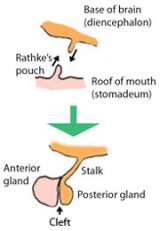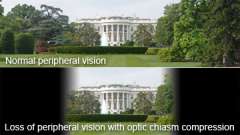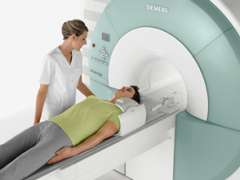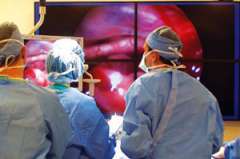Rathke's Cleft Cyst
Find your care
We treat pituitary tumors using the latest innovations in minimally invasive procedures. To connect with an expert in the pituitary tumor program, call 310-825-5111.
Rathke's cleft cyst is an abnormal fluid-filled (cyst) sac that usually is found between the anterior and posterior pituitary glands.
Rathke's Cleft Cyst: Expert Care in Southern California
The UCLA Pituitary Tumor Program offers comprehensive management of Rathke's cleft cyst. Our physicians have years of experience in diagnosing, treating and managing pituitary conditions. We use the most sophisticated diagnostic equipment and offer minimally invasive surgical procedures.

Use the links to explore more about Rathke's cleft cyst:

Rathke's Cleft Cyst: Physiology
What we refer to as the "pituitary gland" is actually made up of two glands: the anterior (adenohypophysis) and posterior (neurohypophysis) glands. As a fetus develops:
- The cells that form the anterior gland migrate from the roof of the mouth (stomadeum).
- The cells that form the posterior gland migrate down from the brain.
The place where the anterior and posterior glands meet is called Rathke's pouch. This pouch normally closes early in fetal development, but a remnant often persists as a cleft. Occasionally, this remnant gives rise to a large cyst called the Rathke's cleft cyst (RCC).
Rathke's cleft cysts that cause symptoms are relatively uncommon lesions, accounting for less than one percent of all primary masses within the brain. They can occur at any age, although most are identified in adults. Rathke's cleft cysts sometimes occur together with pituitary adenomas.
Rathke's Cleft Cyst Symptoms
Often, Rathke's cleft cysts do not cause symptoms. Many times, doctors find the cyst while a patient is undergoing a magnetic resonance imaging scan (MRI) for a different reason. If the tumor grows to a large size, it may cause symptoms because it is compressing surrounding structures.

Larger Rathke's cleft cysts may cause:
- Vision loss. This occurs when the cyst grows upward into the brain cavity, compressing the optic chiasm.
- A loss of the outer peripheral vision, called a bitemporal hemianopsia
- When severe, a patient can only see what is directly in front of them.
- Many patients do not become aware of their visual loss until it is quite severe.
- Other visual problems can include:
- Loss of visual acuity (blurry vision), especially if the cyst grows forward and compresses an optic nerve.
- Colors not perceived as bright as usual
Pituitary Failure or Hypopituitarism
Increased compression of the normal gland can cause hormone insufficiency, called hypopituitarism. The symptoms depend upon which hormone is involved.
- Reduction of sex hormones, luteinizing hormone (LH) and follicle-stimulating hormone (FSH).
- In men, this can lead to a low testosterone level, causing decreased sexual drive and impotence.
- In some cases, there can be loss of body and facial hair.
- In women, this can lead to infertility.
- Large cysts can slightly elevate blood prolactin levels. Doctors think this occurs because of compression of the pituitary stalk, the connection between the pituitary gland and the brain. It is called the "stalk effect."
- In premenopausal women, this can lead to reduction or loss of menstrual periods and/or breast milk production (galactorrhea).
- Prolactin levels are only slightly elevated, as opposed to prolactinomas in which the prolactin level is usually very high.
More severe hypopituitarism can lead to hypothyroidism or abnormally low cortisol levels, which may be life threatening. Symptoms of severe hypopituitarism include:
- Loss of appetite
- Weight loss or weight gain
- Fatigue
- Decreased energy
- Decreased mental function
- Dizziness
You may also experience headaches.
Rathke's Cleft Cyst: Diagnosis
Your doctor will conduct a physical exam and ask you about your symptoms and medical history. Other diagnostic procedures include:
- Imaging scans (usually MRI)
- Hormone testing

MRI Imaging
One method we use to detect Rathke's cleft cysts is a magnetic resonance imaging (MRI) of the pituitary gland. We use a special MRI pituitary protocol in order to best visualize the tumor.
Occasionally, your doctor may order a computed tomography (CT) scans of the brain, though it is less reliable than an MRI scan.
In order to confirm a diagnosis of Rathke's cleft cyst, your doctor will need to rule out other possible conditions that present with a pituitary cyst:
- An arachnoid cyst
- Cystic pituitary adenoma
- Craniopharyngioma

Hormone Testing for Rathke's Cleft Cyst
If your symptoms suggest pituitary failure (hypopituitarism), your doctor will order a complete evaluation of the endocrine system. Based on results of these blood tests, you may need additional hormonal studies. Learn more about hormone testing at the UCLA Pituitary Tumor Program.
Visual Testing
If you are experiencing vision problems, you should visit an ophthalmologist and undergo a thorough evaluation, including:
- Acuity testing of each eye
- Formal visual field testing to determine if there is loss of peripheral vision
Rathke's Cleft Cysts: Treatment
If you are experiencing symptoms, you will require surgery.

Surgery for Rathke's Cleft Cyst
Surgery for Rathke's cleft cysts includes draining the fluid from the cyst.
- If your surgeon needed to remove the cyst wall, you may develop pituitary insufficiency. Often, diabetes insipidus develops.
- "Marsupialization" of the cyst, which means making a large opening at the bottom of the cyst, may prevent cyst recurrence in some cases.
Most neurosurgeons specializing in Rathke's cleft cyst surgery use the minimally invasive endoscopic technique. In experienced hands, the endoscopic approach minimizes complications, hospitalization time and discomfort
This advanced technique requires specialized training and equipment and should be performed at a dedicated pituitary tumor center.
Outcome
The recurrence rate following surgical treatment is about 20 percent. You will need to undergo yearly MRI surveillance to check if the cyst has recurred.
Contact Us
To schedule an appointment with one of our physicians at the Pituitary Tumor Program, please call (310) 825 5111.